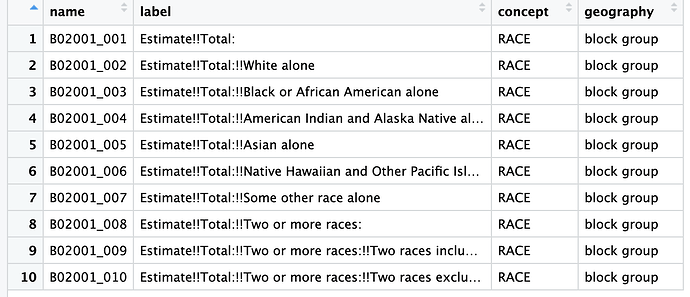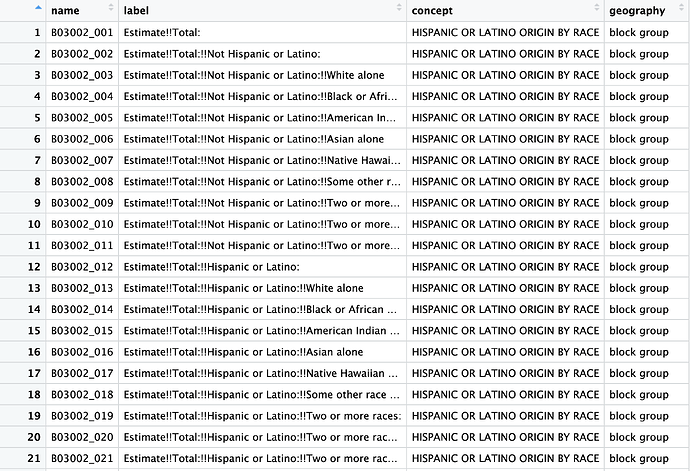The Census distinguishes between race and ethnicity based on the 1997 OMB rulemaking. There are two Census ethnicities: hispanic/latino and not hispanic/latino. People who self-identify as hispanic may be of any race. So for example, former President Alberto Fujimori of Peru had might, had he immigrated to the US have identified as hispanic and as Asian. For purposes of its diversity reports, the Census uses the following categories
- Hispanic
- White alone, non-Hispanic
- Black or African American alone, non-Hispanic
- American Indian and Alaska Native alone, non-Hispanic
- Asian alone, non-Hispanic
- Native Hawaiian and Other Pacific Islander alone, non-Hispanic
- Some Other Race alone, non-Hispanic
- Multiracial, non-Hispanic
The difficulties of racial/ethnic categorization present some of the same difficulties as categorizing continuous variables from a data standpoint. For other uses, it should be recognized that these are social constructs that are highly dependent on context. For example, "white" used to be understood primarily in the sense of people of English, Scottish, Welsh and Protestant Irish. In 1753, Benjamin Franklin described the people of Europe, except those from Saxony, as non-white. He called them "swarthy." A hundred years later, an immigration case turned on whether a Finnish person qualified as "white." A hundred years after that it was still common for people to be referred to in terms of their national or religious origins as "races." The "German race," the "Italian race" or the "Hebrew race." Following the second war, the term "race" dropped away in reference to Europeans and was repurposed primarily as a complexion classifier whose chief purpose was for adverse social and legal treatment.
The current racial classification for the ACS gives some flavor of the difficulties.
American Community Survey
The Race estimates of the population are produced for Puerto Rico, muncipios (county-equivalents for Puerto Rico), places, zona urbanas and comunidades (place-equivalents for Puerto Rico), and minor civil divisions by the American Community Survey.
The U.S. Census Bureau collects race data in accordance with guidelines provided by the U.S. Office of Management and Budget (OMB), and these data are based on self-identification. The racial categories included in the census questionnaire generally reflect a social definition of race recognized in this country and not an attempt to define race biologically, anthropologically, or genetically. In addition, it is recognized that the categories of the race item include racial and national origin or sociocultural groups. People may choose to report more than one race to indicate their racial mixture, such as "American Indian" and "White." People who identify their origin as Hispanic, Latino, or Spanish may be of any race.
OMB requires five minimum categories (White, Black or African American, American Indian or Alaska Native, Asian, and Native Hawaiian or Other Pacific Islander) for race. OMB permits the Census Bureau to also use a sixth category - Some Other Race. Respondents may report more than one race.
The concept of race is separate from the concept of Hispanic origin.
White. A person having origins in any of the original peoples of Europe, the Middle East, or North Africa. It includes people who indicate their race as "White" or report responses such as German, Irish, English, Italian, Lebanese, and Egyptian. The category also includes groups such as Polish, French, Iranian, Slavic, Cajun, Chaldean, etc.
Black or African American. A person having origins in any of the Black racial groups of Africa. It includes people who indicate their race as "Black or African American," or report responses such as African American, Jamaican, Haitian, Nigerian, Ethiopian, or Somali. The category also includes groups such as Ghanaian, South African, Barbadian, Kenyan, Liberian, Bahamian, etc.
American Indian and Alaska Native A person having origins in any of the original peoples of North and South America (including Central America) and who maintains tribal affiliation or community attachment. This category includes people who indicate their race as "American Indian or Alaska Native" or report entries such as Navajo Nation, Blackfeet Tribe, Mayan, Aztec, Native Village of Barrow Inupiat Traditional Government, or Nome Eskimo Community.
Asian. A person having origins in any of the original peoples of the Far East, Southeast Asia, or the Indian subcontinent including, for example, India, China, the Philippine Islands, Japan, Korea, or Vietnam. It includes people who indicate their race as “Asian Indian,” “Chinese,” “Filipino,” “Korean,” “Japanese,” “Vietnamese,” and “Other Asian” or provide other detailed Asian responses such as Pakistani, Cambodian, Hmong, Thai, Bengali, Mien, etc.
Native Hawaiian and Other Pacific Islander. A person having origins in any of the original peoples of Hawaii, Guam, Samoa, or other Pacific Islands. It includes people who indicate their race as “Native Hawaiian,” “Chamorro,” “Samoan,” and “Other Pacific Islander” or provide other detailed Pacific Islander responses such as Palauan, Tahitian, Chuukese, Pohnpeian, Saipanese, Yapese, etc.
Two or more races. People may choose to provide two or more races either by checking two or more race response check boxes, by providing multiple responses, or by some combination of check boxes and other responses. The race response categories shown on the questionnaire are collapsed into the five minimum race groups identified by OMB, and the Census Bureau’s “Some Other Race” category. For data product purposes, “Two or More Races” refers to combinations of two or more of the following race categories: White, Black or African American, American Indian or Alaska Native, Asian, Native Hawaiian or Other Pacific Islander, or Some Other Race.
Data users should be aware of methodology differences that may exist between different data sources.


